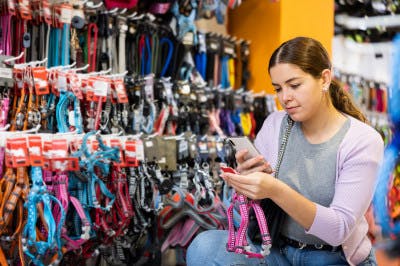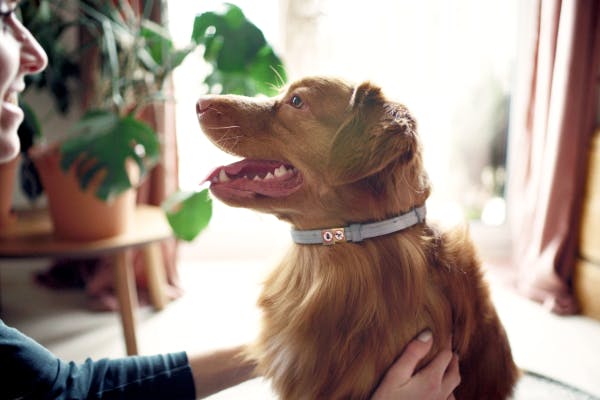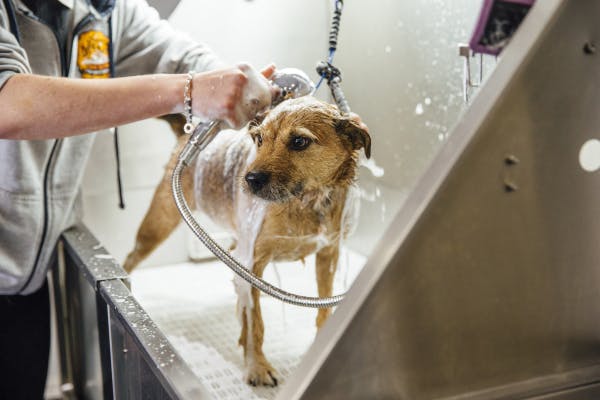Interactive Toys in U.S.A
Best Interactive Dog Toys
Interactive dog toys offer numerous benefits, from mental stimulation to managing behavioral issues. However, safety is paramount. Toys should be appropriately sized to prevent choking risks and regularly checked for potential dangers. Certain toys are recommended for different sizes, ages, or breeds of dogs. Interactive toys can also be used when owners are away to keep dogs mentally and physically engaged.
Why You Should Trust Us
Handpicked interactive toys. Our expert researchers, data analysts, and editors have put more than 55 hours of effort into researching the best available interactive dog toys in the United States. We had researched 762 interactive toys sold in 5 countries before handpicking the 29 best interactive dog toys.
- Hours Researched
- 55+
- Products Researched
- 762
- Products Handpicked
- 29
- Acceptance Rate
- 3.8%
How to choose The Best interactive toy:
Interactive toys are a fantastic way to keep your dog mentally stimulated and entertained. The key feature to look for in these toys is the engagement factor. You want a toy that offers a challenge to your dog. This could be a toy that dispenses treats or one with various textures to explore. These types of toys can hold your dog's attention for longer periods, helping to reduce boredom and potentially destructive behavior.
Another crucial aspect to consider is the durability of the toy. Dogs, especially those who love chewing, can easily destroy toys. So, you need a toy made from robust materials that can withstand vigorous play. Regular inspections for wear and tear are essential to ensure the toy remains safe for your dog.
Safety should always be at the forefront of your mind when choosing an interactive toy for your dog. The best toys are made from non-toxic materials and designed to minimize choking hazards. Consider the size of the toy relative to your dog - small toys can pose a risk for larger dogs, while oversized toys may be difficult for smaller dogs to enjoy. By prioritizing engagement, durability, and safety, you'll provide endless hours of fun for your beloved pet.
3 types of interactive dog toys:
common questions about interactive toys:
- What are the benefits of interactive dog toys for my dog's mental and physical health?
- Key Factors to Consider When Choosing an Interactive Dog Toy
- How to Introduce Your Dog to a New Interactive Toy
- How can interactive dog toys assist with behavioral issues?
- Can interactive dog toys be utilized when I'm not present?
Snuffle Mats
- our rating97 out of 100
- our rating90 out of 100
- our rating90 out of 100
Snuffle mats offer many benefits for dogs, promoting mental and physical well-being. These mats are designed to hide dry food, encouraging dogs to use their natural foraging skills while eating. Some of the top benefits of snuffle mats include:
Mental stimulation: Snuffle mats engage a dog's curiosity and help prevent boredom, which can lead to destructive behaviors. They provide a challenging activity that keeps dogs mentally stimulated.
Slower eating: Fast eating can cause health issues in dogs, such as vomiting, stomach pain, and bloat. Snuffle mats slow down the eating process, helping to prevent these problems.
Reduced begging: When dogs eat more slowly, they tend to feel fuller and more satisfied after their meals, which can lead to less begging for food.
Energy burning: Using a snuffle mat can burn as much energy as an hour of walking for a dog. This makes them ideal for high-energy dogs or those with limited mobility.
Entertainment: Snuffle mats serve as both a feeding tool and a form of entertainment for dogs, keeping them engaged during mealtime or playtime.
Anxiety reduction: Snuffle mats can provide mental stimulation and a sense of accomplishment for dogs suffering from separation anxiety.
Puzzle Toys
- our rating91 out of 100
- our rating89 out of 100
- our rating87 out of 100
Dog puzzle toys offer a fun way to engage your canine's mental and physical abilities while providing numerous benefits. These toys stimulate your dog's mind, helping combat boredom and reduce anxiety. As your dog tackles these puzzles, they exercise not only their brains but also their muscles, promoting overall health.
Puzzle toys also help slow down fast eaters, reducing choking or indigestion risks. As your dog accesses treats through the toy, they're more likely to savor each bite instead of rushing. Furthermore, these toys foster positive behaviors by providing appropriate outlets for foraging, chewing, and problem-solving, preventing destructive habits.
Learn About Puzzle Toys
Treat Dispensing Toys
- our rating95 out of 100
- our rating94 out of 100
- our rating93 out of 100
Treat dispenser toys have many benefits for dogs, making them a great addition to your pet's daily routine. These toys promote mental stimulation, helping to reduce boredom and prevent destructive behavior. They also serve as slow feeders for dogs that eat too fast, reducing the risk of choking, vomiting, or bloating.
Treat dispenser toys also increase physical activity, encouraging dogs to play and exercise. As a result, these toys are a fun and interactive way to keep your pet healthy and happy.
Learn About Treat Dispensing Toys
Questions About Interactive Toys
What are the benefits of interactive dog toys for my dog's mental and physical health?
Interactive dog toys give your dog hours of fun and many mental and physical benefits. These toys can help your dog fight boredom, so they're less likely to chew on furniture or bark a lot. When your pet plays with interactive toys, their mind gets a workout, keeping them happy, busy, and away from unwanted behaviors.
Playing with interactive dog toys can also sharpen problem-solving skills as your pet learns how to get treats or solve puzzles. This mental stimulation helps keep their brain healthy. As for their physical health, interactive toys help them exercise and stay active, which is good for strength, stamina, and agility. In the end, both mental and physical benefits promote your dog's happiness, health, and long life.
Key Factors to Consider When Choosing an Interactive Dog Toy
When picking an interactive dog toy, think about your dog's size, activity level, likes, safety, variety, and need for mental stimulation. This will help you find a toy that is fun, safe, and engaging for your pet.
Size: Pick a toy that fits your dog's size. For example, balls should be big enough to carry but not too small to swallow or get stuck in their throat.
Activity level: For active dogs, choose toys made of strong materials like hard rubber or rope. For less active dogs, soft plush toys or squeaky toys may be better.
Likes: Watch how your dog plays and pick toys they will enjoy. Some dogs like fetch games, while others like chewing or tugging.
Safety: Stay away from toys with sharp edges or pointy parts. Make sure any pieces that could be chewed off and swallowed are removed or hard to reach.
Variety: Give your dog different types of toys to keep them interested and entertained. This can include balls, plush toys, rope toys, and treat-dispensing toys.
Rotate toys: Keep your dog excited about their toys by only giving them a few at a time and changing them every week.
Interactive toys: Many of your dog's toys should be interactive to help with mental stimulation and bonding between you and your pet.
Watch playtime: Keep an eye on your dog while they play with their toys, especially if they chew a lot or break things easily.
How to Introduce Your Dog to a New Interactive Toy
To help your dog get interested in a new interactive toy, be patient, use positive reinforcement, and make the toy appealing. Here are some steps to follow:
Pick the right time: Show your dog the new toy when they are awake and want to play. Don't do it when they are tired or not paying attention.
Make the toy appealing: If the toy has treats or food, use your dog's favorites to make it more exciting. For other toys, try using smells your dog likes, such as a little peanut butter or a drop of essential oil.
Show excitement: Your dog will notice if you are excited about the new toy. Use a happy voice and body language to get them interested in the toy.
Show how the toy works: Some interactive toys need help for your dog to understand how to use them. Show your dog what to do by using the toy yourself or with another toy as an example.
Use positive reinforcement: Praise and reward your dog when they show interest in the new toy or use it correctly. This can be with kind words, petting, or a small treat.
Be patient: Your dog might need time to get used to a new interactive toy, especially if it is hard or needs problem-solving skills. Let them explore and learn at their own speed.
Watch playtime: Keep an eye on your dog while they play with their new toy to make sure they are using it safely and the right way. If needed, step in to help them or change the toy's difficulty level.
How can interactive dog toys assist with behavioral issues?
Interactive dog toys aid in mitigating behavioral issues in dogs by providing mental stimulation, which prevents boredom. Boredom often triggers problematic behaviors like excessive chewing or digging. These toys engage a dog's problem-solving skills, keeping them mentally active and less likely to engage in destructive behaviors.
Interactive toys also help manage stress and anxiety in dogs. Dogs often resort to destructive behaviors when anxious or stressed. Keeping them occupied with interactive toys reduces their stress levels and decreases the chances of destructive behavior.
Some interactive toys are purposely designed to slow down a dog's eating pace. This is especially helpful for dogs that eat too fast, a behavior that could lead to choking, vomiting, or even serious health conditions.
Additionally, interactive toys help redirect destructive behavior. For dogs prone to inappropriate chewing or scratching, an interactive toy provides a healthier outlet for their energy and curiosity.
In essence, interactive toys are an effective tool for managing various behavioral issues in dogs by offering mental stimulation, stress relief, and suitable outlets for natural canine behaviors.
Can interactive dog toys be utilized when I'm not present?
Yes, interactive dog toys can indeed keep dogs occupied when their owners are away. These toys, which stimulate dogs' natural instincts such as hunting and foraging, can keep them engaged both mentally and physically. They are particularly beneficial for dogs suffering from separation anxiety. Some of these toys are electronic and can be programmed to function automatically for long durations. However, it is crucial to ensure that the toy is safe for the dog to play with unsupervised and that it's appropriate for the dog's size and chewing tendencies.




















